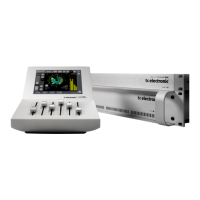105
bACkDrOP
you can selectively reduce each of these three components
whileminimizingtheprocessingappliedtothesignalyou’re
cleaning up.
ThewayinwhichBackDropdecomposesthenoiseinto
three components is best described in the frequency
domain as illustrated in above figures. The first figure
shows the spectrum of the composite noise (i.e. Buzz,
Room noise and Hiss combined). The second figure
showshowBackDropdecomposesthenoiseintothe
three components. The Buzz component consists of the
tonal parts of the noise. The Room component consists of
the broadband noise that does not have a flat spectrum.
The Room component is often dominated by lower
frequencynoise.Finally,theHisscomponentconsists
of the broadband noise having a relatively flat spectrum.
In the example shown in the figure the noise at higher
frequenciesispredominantlyduetohiss.BackDropallows
you to selectively reduce each of these noise components.
The MultiType model is a good choice when the noise
is made up of two or more components or when you
have noise (such as hum due to ground loops) with clear
tonal components. The MultiType model provides six
primary controls (Buzz Aggression, Room Aggression,
Hiss Aggression, Max Reduction, Basilar Dispersion, and
Transient Recovery).
Buzz Aggression
Buzz Aggression controls the overall amount of processing
applied to the tonal components of the noise. Buzz
Aggression can range from 0% to 100% with 0% meaning
that no processing is being applied to the signal. The
BuzzAggressionparameterworksinconjunctionwithMax
Reduction.
Examplesofnoisesourceswithtonalcomponentsinclude
hum(50or60Hz)duetopowerlinesandgroundloopsas
well as the tonal components due to the cyclical nature of
some noise sources such as air conditioners, cooling fans,
harddisksorCRTfly-backtransformers.
Room Aggression
Room Aggression controls the overall amount of
processing applied to any broadband noises that do not
have a flat spectrum. It is an aggression control for the
colored (non-flat) broadband portion of the noise. Room
Aggression can range from 0% to 100% with 0% meaning
that no processing is being applied to the signal. The
RoomAggressionparameterworksinconjunctionwithMax
Reduction.
Typical examples of noise sources that are targeted by
the Room Aggression parameter include room noises due
to air conditioning units or cooling fans, as well as the low
frequency rumble due to traffic noise or air movement in a
large hall.
Hiss Aggression
Hiss Aggression controls the overall amount of processing
applied to any broadband noises having a flat spectrum.
Hiss Aggression can range from 0% to 100% with 0%
meaning that no processing is being applied to the signal.
TheHissAggressionparameterworksinconjunctionwith
Max Reduction. Typical examples of broadband noise
sources having a flat spectrum include tape hiss and
quantization noise.
The Max Reduction, Basilar Dispersion, Transient
Recovery, and Link Controls function exactly as in the
Basic Model.
Print Screen
The Print screen contains all of the controls needed to
capturetheinformationrequiredbyBackDropregardingthe
characteristicsofthenoise.BackDropwillnotreducethe
noise properly unless you have provided it with a suitable
noise print. This screen provides five parameters (Capture,
Calculate,Play,TrimStart,andTrimEnd).
Capture
TheCapturecontrolcausesBackDroptoautomatically
capture(record)1.5secondsofaudiotouseintheanalysis
of the noise characteristics.
When in playmode, capture is not available
Calculate
When Capture is pressed, the Capture button is lit while
BackDroprecords1.5secondsofaudio.Duringthis
timethestatuswindowwillindicatethatBackDropis
recording the audio. Once the audio has been captured,
the Calculate button will automatically light up and the
statuswindowwillindicatethatBackDropiscalculatingthe
noiseprintinformation.BackDroptakesafewsecondsto
calculate the noise print information since it is analyzing the
noise data and calculating the noise print information for
each of the three models (Basic, MultiBand and MultiType).
There are often times when it is necessary to recalculate
the noise print information without capturing new audio.
Forexample,itisnecessarytorecalculatethenoiseprint
informationaftertheTrimStartandTrimEndpointshave
been altered (see below). In this case, press the Calculate
buttontohaveBackDropupdatethenoiseprintinformation
based on the audio contained between the Trim Start and
TrimEndpointsofthecapturedaudiobuffer.
It should be noted that when switching between Stereo and
M/Sprocessingmode,BackDropautomaticallyrecalculates
the noise print information for the current operating mode.

